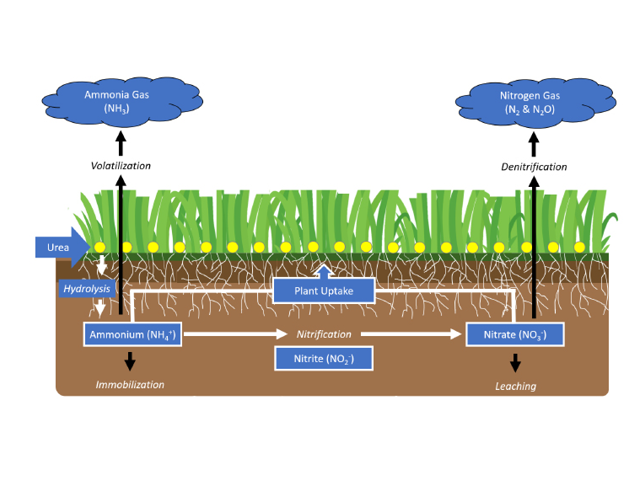Reducing Nitrogen Volatilization

As the number one source of nitrogen (N) in the world, urea is considered one of the most important inputs for managing plant growth. While urea has many benefits, including its cost and storage, it comes with some significant disadvantages. Fifty percent of applied urea can be lost before it can be absorbed by the plant. To be utilized by plants, urea molecules must first convert to ammonium (NH4+) to be absorbed. Unfortunately, much of the freshly converted NH4+ immediately converts to ammonia (NH3) gas, which is lost to the environment via volatilization. Another potential loss of NH4+ is through nitrification, a process involving the conversion of NH4+ to nitrate (NO3-). NO3- is also available for plant uptake, but is prone to leaching and denitrification, a process where NO3- converts to N2 or N2O gas. Similar to what occurs with volatilization, this N is completely lost.
A number of different technologies have been developed to combat N losses, such as the use of urease and nitrification inhibitors, often referred to as stabilized nitrogen. Urease inhibitors reduce the activity of the urease enzyme, limiting volatilization. Nitrification inhibitors work to prevent NH4+ conversion to NO3-. For N stabilization, Helena recommends N-Fixx® Duro, a fertilizer additive that can be used on urea or urea ammonium nitrate (UAN).
Slow and controlled-release technologies are commonly used to improve efficiency. The terms “slow” and “controlled release” are often used interchangeably. However, slow-release fertilizers require microbial degradation for release, while controlled-release fertilizers are coated. Slow-release N sources are modified forms of urea combined with an aldehyde, resulting in varying length chained methyls. Common terms you may hear are methylene urea, urea formaldehyde or ureaform, as well as urea-triazone. Coron® Metra from Helena is a foliar-applied methylene urea solution that releases over time and is a great alternative to granular slow-release options.
When it comes to controlled-release fertilizers, there are typically sulfur (S)-coated products or polymer-coated (PC) products. Some options are available with a sulfur plus polymer coating as well. Helena’s polymer-coated urea utilizes the newest and most advanced coating on the market. These polymer-coated products are available in 30-day to 360-day release periods.
Raw urea requires frequent reapplication, and fifty percent or more can be lost before the plant has a chance to absorb it. There are many ways to improve urea efficiency and utilization, including stabilization, slow-release and controlled-release options. Each of these options has their own considerations, and the one you use depends on many factors, including the time of year, location, species grown, and most importantly, your goals and fertilization strategy. To learn more and get custom recommendations, contact your Helena representative today.
